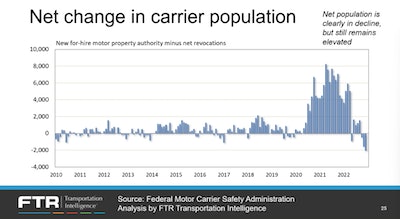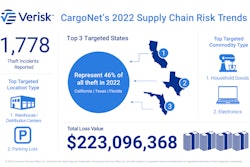 The explosion of new motor carrier authorities over the course of the COVID-19 pandemic ended this past year, with carrier authority revocation numbers exceeding new authorities as spot market opportunity declined.
The explosion of new motor carrier authorities over the course of the COVID-19 pandemic ended this past year, with carrier authority revocation numbers exceeding new authorities as spot market opportunity declined.
FTR Transportation Intelligence's monthly "State of Freight" online seminar series kicked off 2023 with a close look at the trajectory of a variety of trucking market indicators. Broadly speaking, analysts project a fairly flat to down market for freight movement writ large for the foreseeable future.
Of perhaps most import for owner-operators both leased and independent is the forecast of relative stability, compared to 2022, for contract and spot freight markets. The long and unprecedented surge in new carrier authorities that began following the early COVID period lockdowns in 2020 (illustrated above), with a spot market freight surge, came to a definitive end in 2022. Authority revocations were "at the highest levels" ever late in 2022, said FTR Trucking Vice President Avery Vise. Demand in the contract freight sector allowed many newly-minted authorized one- or just-a-few-truck carriers a fallback, leasing to a larger motor carrier.
For the year ahead, that fallback may well be less of a sure thing. Projections for freight demand industry-wide from FTR are flat, generally speaking, Vise noted. "As we lose drivers from carriers failing, in all likelihood we may lose them totally" in the coming year.
The good news for owner-operators with authority who remain steadily profitable? After sinking mightily through the first few quarters of the year, spot rates had "leveled off by the Fall period," according to Vise, and showed signs of returning to something like the pre-pandemic "normal" with a "big jump at the end" of the year, a typical past seasonal pattern. "That big jump doesn’t tend to stay" very long, and "we’ve already come down a little," as also reported just this past week.









